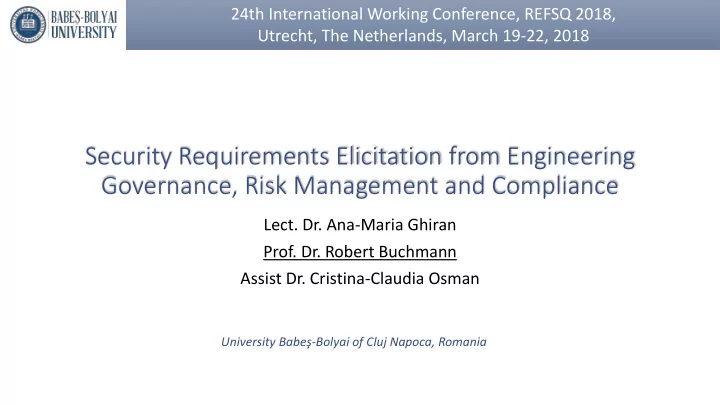

24th International Working Conference, REFSQ 2018, Utrecht, The Netherlands, March 19-22, 2018 Security Requirements Elicitation from Engineering Governance, Risk Management and Compliance Lect. Dr. Ana-Maria Ghiran Prof. Dr. Robert Buchmann Assist Dr. Cristina-Claudia Osman University Babe ş -Bolyai of Cluj Napoca, Romania
Agenda • Motivation • The Vision of GRC Security Requirements Engineering • Key Proposal • Examples: — Access control policies in RDF — Diagrammatic Knowledge Sources • Conclusions REFSQ 2018 2
Motivation Security requirements have heterogeneous sources and representations, often implied by contextual documentation (rather than explicitly formulated by stakeholders) Governance Risk management Compliance Regulatory obligations Internal control policies, Risk mitigation policies “ appropriate safeguards Guiding standards “ username and passwords should be in place to “ username must not be must not be related” protect user data like related to person” login credentials” - GDPR REFSQ 2018 3
Motivation Security requirements have heterogeneous sources and representations, often implied by contextual documentation (rather than explicitly formulated by stakeholders) GRC Governance Risk management Compliance Regulatory obligations Internal control policies, Risk mitigation policies “ appropriate safeguards Guiding standards “ username and passwords should be in place to “ username must not be must not be related” protect user data like related to person” login credentials” - GDPR REFSQ 2018 4
Motivation GRC advocates integration GRC disciplines treated separately: Integrated GRC disciplines: - some might be unaware by the requirements - enable richer and comprehensive requirements identified in the other areas - opportunity for a " security requirements - tasks are repeated, activities and costs are knowledge base " duplicated Governance Risk Management Compliance REFSQ 2018 5
The Vision of GRC Security RE Proposal: a security requirements knowledge base that is… - machine-readable - linkable to data Underlying technology: Semantic technology (RDF, OWL) Technical Challenge: Knowledge conversion processes and adapters (to unify the repository under RDF) REFSQ 2018 6
Key proposal RDF (Resource Description Framework) – unifying format employed here to represent (and semantically link) requirements from heterogeneous sources: • textual sources => manual translation • visual (diagrammatic) sources => automated translation • ontology-based sources => semantic integration with existing knowledge sources REFSQ 2018 7
Background on RDF "Knowledge graphs" are formed by connecting statements: :UserX :hasPassword :UserXPasswordA. :UserXPasswordA :currentValue "abcdefgh". :UserXPasswordA :forAsset :AssetX. : hasPasword : forAsset :UserX :UserXPasswordA :AssetX : currentValue abcdefgh graph databases can be employed for storage and semantic queries: Retrieve users that have set a password for asset X SELECT ?user WHERE { ?user :hasPassword/:forAsset :AssetX } => UserX * https://www.w3.org/TR/sparql11-query/ REFSQ 2018 8
OWL* axioms and inferences on password policies :WeakPassword owl:unionOf (:NoDigitsPassword :NoSymbolPassword :ShortPassword). =>NoDigitsPassword rdfs:subClassOf :WeakPassword. :NonCompliantUser owl:onProperty :hasPassword; owl:someValuesFrom :WeakPassword; rdfs:subClassOf :User. :UserXPasswordA a :NoDigitsPassword. =>:UserXPasswordA a :WeakPassword. => :UserX a :NonCompliantUser. :AssetX a :VulnerableAsset. :NonCompliantUser SPARQL Query: :WeakPassword Retrieve the noncompliant users a :hasPassword UserX :UserXPasswordA rdfs:subClassOf SELECT ?x WHERE :NoDigits {?x a :NonCompliantUser} Password * https://www.w3.org/TR/2012/REC-owl2-overview-20121211/ REFSQ 2018 9
Converting diagrammatic sources: UML <http://www.security.org/example#Extend_UML- 13054-One-Time-Password_authentication- <http://www.security.org/example#Use_Case_UML-13045- Online_authentication> Online_authentication> a cv:r_Modelling_relation_a , a mm:o_Use_Case_UML , cv:o_Modelling_object ; mm:r_Extend_UML ; cv:a_Name "Online authentication" . cv:from <http://www.security.org/example# Use_Case_UML-13048-One-Time- Password_authentication> ; Online Authentication: cv:to <http://www.security.org/example# Use_Case_UML-13045-Online_authentication> . Uses cases and abuse cases described diagrammatically AND as a graph amenable to reasoning <http://www.security.org/example#Association_UML-13056-Customer-Online_authentication> a mm:r_Association_UML , cv:r_Modelling_relation_a ; cv:from <http://www.security.org/example#Actor_UML-13003-Customer> ; cv:to <http://www.security.org/example#Use_Case_UML-13045-Online_authentication> . REFSQ 2018 10
Converting diagrammatic sources: SecureTropos Threat case description in :SecurityObjective-14036-SecurityObjective-14036 a ns0:SecurityObjective , cv:Instance_class ; SecureTropos ns0:Name "SecurityObjective-14036" ; <http:// www.security.org/example #Object's_name> "Authorisation" ; :SecurityMechanism-14027-SecurityMechanism-14027 a ns0:SecurityMechanism , cv:Instance_class ; ns0:Name "SecurityMechanism-14027" ; <http:// www.security.org/example #Object's_name> "One time password" ; REFSQ 2018 11
Conclusions • Our approach advocates semantic integration of multiple sources for security requirements • A requirements knowledge base can enable a shared, traceable and formal representation of requirements REFSQ 2018 12
On-going work An integrative schema to unify • several (security) requirements diagram types (SecureTropos, UML use cases) • other types of documents that are commonly used in integrated GRC (mostly rules) • security data that should be assessed against GRC policies A Question/Answer interface to retrieve information from the hybrid knowledge base REFSQ 2018 13
Thank you! robert.buchmann@econ.ubbcluj.ro REFSQ 2018 14
Recommend
More recommend